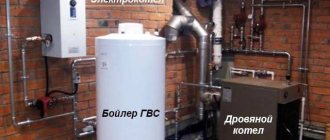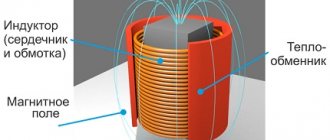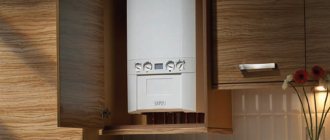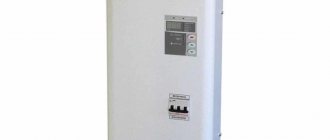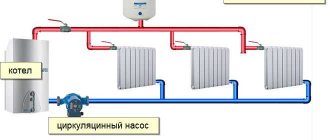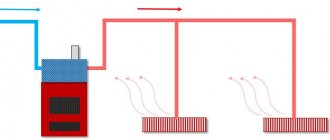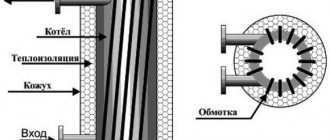Solid fuel
Not so long ago, solid fuel had no competitors. At first, firewood, and then coal, were the main types. Of course, they also burned peat, straw and even dung, but, as now, it was “local” fuel that was not widely used.
The primitive hearth in the cave is very reminiscent of a classic fireplace Source cottage.ru
With the beginning of the “gas era,” heating, firewood and coal faded into the background, but still remain in demand. Moreover, their prospects are “rosy”, since there are much more proven reserves of coal than gas, and firewood and “wood” fuel are renewable energy sources. The only modern difference is that previously only stoves or fireplaces were used to heat a house, but now a boiler is considered the main source of heat. Although there are exceptions.
They are still found today, especially when it comes to a small country house or dacha. The main advantage is absolute energy independence. Therefore, they are used when it is necessary to provide heating for a private home without gas or electricity.
Depending on their purpose, stoves can be either heating or heating-cooking. The first option includes a Russian stove and a Swedish stove, the second - a Dutch oven and a classic fireplace.
Heating and cooking stove Source bioenerga.gr
Their effectiveness largely depends on the design of the chimney system, of which there are three types:
- Straight-through. The chimney has a minimum number of bends in the direction from the firebox to the pipe. This category includes classic open-hearth fireplaces and Russian stoves. The radiator of heat is the body and part of the chimney that runs indoors or inside the wall. By the way, thanks to its special design and massiveness, the Russian stove is considered one of the most efficient. And a traditional fireplace has the lowest efficiency. And in modern realities it is more of a decoration or a means of relaxation while contemplating an open flame than a full-fledged heater.
- Duct. Combustion products are removed using a system of channels passing inside the furnace body, which not only emits, but also accumulates heat. The “Dutch” belongs to this type. It, like a Russian stove, takes a long time to warm up, but also takes a long time to cool down.
- Bell bells. Hot gases first rise into the “hood”, where they give up some of the heat, cool, fall along the walls of the hood and are drawn out into the chimney through the “hood”.
In addition to non-volatility, the advantage of classic stoves is their “omnivorousness” in relation to solid fuel. Firewood, coal, peat, briquettes - everything that can be put in the firebox with your hands and set on fire. Moreover, unpretentiousness extends to the ash content of coal and the moisture content of firewood.
The Russian stove is still relevant and can heat several rooms on two levels Source yandex.uz
The disadvantages are no less significant than the advantages:
- radiation type of transfer of thermal energy - one stove heats a house where the entire living area is contained in one or two adjacent rooms;
- labor-intensive maintenance - frequent refilling of fuel and cleaning;
- low efficiency (efficiency on average about 20%) - the fuel does not burn out completely and most of the heat “flies down the chimney” along with the smoke;
- a complex hand-made design that can only be performed by an experienced craftsman.
Modern solid fuel boilers and factory fireplace inserts do not have these disadvantages.
See also: Catalog of companies that specialize in insulating country houses.
Solid fuel boilers
Another not the worst option than heating the house. Modern solid fuel boilers have an efficiency of 80-95%. That is, the best examples of operating efficiency are at the level of gas boilers, and only three economic factors “throw them back” into second place:
- higher cost of coolant per kilowatt of thermal energy;
- higher price of equipment;
- “there are” maintenance costs (costs of transport, fuel storage and disposal of solid residues).
If we talk about cost, then in the Moscow region, heating with wood is approximately one and a half times more expensive than gas - about 90 kopecks. per kilowatt versus 53 kopecks. (at tariffs for natural gas for the second half of 2021, subject to the availability of metering devices).
Pyrolysis boilers have the highest efficiency - the wood in them burns almost completely, with minimal “solid” residue Source pogreb-podval.ru
The use of fuel pellets increases the cost per kilowatt to 1.3-1.4 rubles. and is almost comparable in price when using coal, but still 15-20% cheaper than heating with anthracite. But there are nuances here.
If the task is how to heat a house cheaply without gas, then long-burning wood boilers or pyrolysis (gas generator) models best meet this condition. The only drawback is that laying firewood is done manually and it is impossible to automate this process. Although this should be done infrequently - 1-2 times a day. Also keep in mind that you need to carefully check the information about the so-called “magic” long-burning wood-burning boilers.
Pellet or coal boilers are available with automatic loading of fuel from the bunker. And although the bunker also needs to be loaded manually, it is much larger than the volume of the firebox. A regular boiler model with a standard hopper with a capacity of 1 m3 can operate continuously from three days to a week, and with an enlarged hopper - up to 12 days (taking into account high-quality insulation of the house and low heat loss). And when it is not possible to frequently load fuel, then these boilers are the best option (if you do not take into account higher prices for equipment).
Long-burning solid fuel boilers with a large-capacity hopper do not require daily maintenance from the owners Source kaminyn.ru
Note. There are even automatic modular coal boilers with a bunker volume of up to 14 m3, their own crusher, auger fuel supply to the firebox and automatic soot removal into their own bunker - practically a mini-boiler room for a private home. Moreover, this is a domestic development and the cost of the equipment is also “domestic”.
Fireplace inserts
Modern fireplace inserts, fireplace stoves and stoves do not differ in operating principle from solid fuel boilers. They also have the function of long burning and secondary combustion. Their efficiency differs from gas generator boilers by only 5-10%, which is at least four times higher than that of classic fireplaces with an open firebox.
Demonstration model of a closed fireplace insert with a water circuit Source bestpechi.ru
Cheap options
Relatively cheap types of heating your home without gas or electricity include stove and gravity. The latter type includes quite popular heating schemes, called “Leningradka” and “Spider”. Let's take a closer look at all of them.
Stove heating
This type of alternative heating without dependence on gas and electricity is relevant for rural and township one-story houses of small and medium area. For private houses with a kitchen and one recreation room, it is enough to install a metal or brick stove without, for example, installing a water or steam heating circuit. For houses with a large number of rooms, it is necessary to install a pipe heating system with radiators. Such stoves are heated with wood, cellulose waste, pressed sawdust briquettes, wood pellets and coal. The laying of brick stoves should be provided for at the design stage of the house. A metal stove can be installed without any problems in an already built building.
This type of heating is not suitable for two-story cottages; a solid or liquid fuel boiler with a loop circulation system is required.
Gravity heating
The gravity heating scheme is quite simple: a solid fuel boiler is installed (this type of boiler is usually marked “TT”) or a good stove, inside which a heating element (heat exchanger) is mounted. And from this heater, pipe distribution is installed throughout the rooms of the house with the installation of batteries or pipe heaters.
The pipe system has a closed cycle: water is filled into the pipe system from the top point (from the attic, where the so-called open-type expansion tank is installed) until the entire system is filled until a constant level of liquid appears in the expansion tank. The boiler or stove is heated, the water in the heater heats up, and a slight pressure appears, which pushes still cold water further into the pipe system. As a result of heating, the process of liquid movement begins along the circuit from the stove (boiler) to the batteries located in the rooms, and then upward - into a common collector, called by heating engineers “return”, which returns the already cooled water back to the water heater of the stove or boiler. Initially, this scheme was practiced in heating without gas, but with the advent of floor-standing gas boilers it began to be used with it. Gravity heating does not require electricity. But it is important to understand its pros and cons .
In such a system, it is important to monitor the water level in the expansion tank. When the level decreases, it is necessary to add water to the system, otherwise you can disrupt the gravity flow process and even burn out the heater pipeline located in the firebox.
In gravity heating of private houses, two wiring systems are mainly used:
- "Leningradka";
- "Spider".
It is worth dwelling on their description.
Leningradka
An example of single-pipe distribution using polypropylene pipes.
This heating distribution system is the simplest and cheapest. It consists of a single-pipe circuit, in which a direct hot water pipeline from the heating boiler diverges sequentially to all objects, gradually losing heat as it moves from room to room. This solution is especially relevant in one-story houses with heating radiators located at the same horizontal level. When using this wiring in a two-story building, it will be impossible to do without a circulation pump.
Spider
The distribution of gravity heating according to the “Spider” scheme can be considered completely autonomous in the absence of electricity and gas. In such cases, it is best to install a solid fuel boiler. The scheme differs in that hot water is distributed in parallel from the upper collector to the heating radiators, so the coolant temperature in all rooms will be the same. This wiring diagram is quite accessible even for a two-story mansion. The main disadvantage is the difficulty of installing pipelines, since it is necessary to accurately calculate their diameter at the supply to individual batteries in houses with more than one level.
These heating systems are easy to make with your own hands.
Liquefied gas
In terms of cost per kilowatt of energy, liquefied gas ranks third.
There are different ways to deliver and store it, but the smaller the volume, the more expensive the final price. Therefore, a gas holder is needed for a permanent home, and for a small dacha, which is rarely visited in cold weather, you can get by with several 50-liter cylinders. When using a gas holder, the price of a kilowatt of heat from burning liquefied gas is 2.3-2.5 rubles, the use of cylinders raises the bar by 50 kopecks.
You can also heat yourself in different ways.
The simplest system is direct combustion of gas to produce heat without heating the intermediate coolant, pipework and radiators. For this purpose, gas convectors and infrared heaters are used. Their operating principle and design are different, but they have one thing in common - availability of equipment, compactness and operation from bottled gas. The disadvantage is the power limitation and heating of only one room. For example, infrared and catalytic gas heaters from AYGAZ have a maximum power of 6.2 kW.
With such a compact infrared heater you can heat up to 40 m2 Source vps-region.ru
Heat pumps
Such heat is extracted from nothing, just from the air. This is an air conditioner in reverse. The pump itself does not produce heat, it only extracts it from the medium and sends it in the desired direction.
Operating principle
The principle of operation of the pump is to take heat from the environment in which it is placed. However, the pump needs starting energy. For example, in order to move 10 kW of thermal energy, it needs to consume about 3 kW of electricity.
The difference is impressive! And if electricity is available, it allows you to choose a heat pump for economical heating of a private house without gas.
Features and prices
However, the problem is that in severe frosts such a pump malfunctions. Works well in frosts down to −15, stops working at −30. There is one more drawback - with practically free energy, the pump itself is very expensive - from 200,000 to 1,500,000 rubles.
Liquid fuel
This is probably the last option that should be considered when solving the problem of how to heat a house if there is no gas. It's not even about the price of energy resources - they can be different. The most expensive diesel fuel allows you to obtain thermal energy at the same cost as using liquefied gas from cylinders. The price of heat when burning fuel oil is the same as that of coal-fired boilers, and “working off” practically compares heating costs to the level of natural gas. But…
In terms of equipment cost, this is one of the most expensive fuel-using systems. In addition, these boilers are “capricious”, requiring regular maintenance and the same complexity of maintenance as the fuel supply and injection systems of a diesel car. There are also disadvantages such as air pollution from liquid fuel combustion products, as well as high noise levels from the operation of the fuel pump and burner.
Maintenance of an oil-fuel boiler is much more difficult than any other Source enemcon.com
We heat the house without gas and wood
If suddenly in the area where you have a country house, it is not possible not only to connect to a gas pipeline, but also to use firewood for heating, then today there are excellent alternative types of fuel for heating that can solve this seemingly serious problem.
And, first of all, let's consider a method such as electric boilers. But let us immediately note their significant drawback - that electricity is a very expensive source of heat.
That's why people are trying to find alternative ways. Typically, heating without gas and wood involves the use of environmentally friendly materials and technologies that nature itself creates and gives us. And one option is a heat pump. Such equipment is very common; thanks to a heat pump, you can effectively heat your home using heat that is taken from water, soil, and the bowels of the earth.
Heat pump
The only downside to heat pumps is that the initial installation cost is quite high. However, we note that it pays for itself in full over the entire life of the equipment, since there are no additional costs for maintenance.
Among the advantages of heat pumps, we note the following:
- Low fuel prices.
- Ease of installation and maintenance of equipment.
- The system is safe for human health and the environment.
- The energy efficiency is high and even a large house can be heated with minimal costs.
Electric boilers
Electric boilers have the highest efficiency - up to 98%. Moreover, it does not depend on the type of boiler. Heating element, electrode and induction boilers differ only in the method of heating the coolant, and they have no losses from incomplete combustion of fuel - electricity is almost completely converted into heat. In principle, it would be correct to talk not about the heating system (there is no fuel and combustion chamber), but about the heating method.
In terms of equipment cost, simplicity of design, complete automation and ease of maintenance, electric boilers have no competitors. But their cost per kilowatt of thermal energy is the highest. Although there are loopholes here.
Solar heating
It is possible to convert solar energy into thermal energy only if the sun shines frequently and for a long time over the roof of your house. Unfortunately, 80% of Russian territories have nothing to do with this. However, even in warm climates you cannot rely solely on solar heating; a backup source is definitely needed.
Principle of operation
Light-absorbing batteries are installed in place “under the sun,” which process solar energy directly into thermal energy and then transfer it to the coolant. There are two types of solar collectors - vacuum and flat. Vacuum ones are considered the most efficient and economical. Using solar energy is an achievement of science.
Price
The advantage of solar heating is the low price of solar collectors. Flat devices can be purchased at prices ranging from 1,500 to 60,000 rubles. Vacuum ones are much more expensive - about 80,000 rubles. However, if you consider that you don’t have to pay for fuel, the price is quite reasonable.
Video description
In addition, you can use modern geothermal pumps, which are clearly explained in the video:
The heat accumulator can optimize the operation of any heating system
But the main disadvantage of heating with electricity is the poor quality of networks and power limits.
How to cheaply heat your home
There are a great many options for heating units and systems. Most of them convert the energy of fuel combustion into thermal energy, facilitating the best distribution of warm air indoors.
Warmth of the hearth
Types of heating
The heating of high-rise apartments is most often central, although now many houses are switching to autonomous systems, which is considered much more profitable in terms of quality and economics. In low-rise buildings, private country houses, and dachas, heating can be installed:
- Also steam central,
- Autonomous gas or electric,
- Stove using various types of fuel,
- Fireplace.
You can have heating installed without pipes and communications, consisting of only one heating device, or an entire system with batteries and pipe lines.
Cheapest fuel
Heating devices can use various fuels - solid, liquid, gaseous, electronic. At the same time, its traditional types are not always more convenient or cheaper for the consumer:
Stove complex with fireplace
- Electricity is the simplest way to organize heating, but also one of the most expensive,
- Gas heating is cheaper, but you need to take into account that main and liquefied gas are slightly different things, since the basis of centrally supplied gas is methane, and the substance in the cylinders is propane-butane, the combustion of which is 4-5 times more expensive;
- Diesel fuel is also quite expensive (1 Gcal of heat will cost more than 3.5 thousand rubles), which creates an unpleasant odor near the heating apparatus, although it can become an affordable alternative to centrally supplied fuels,
- Coal is a fairly cheap fuel, with which heating will cost 3-4 times less than with diesel fuel (1 Gcal of heat will cost about 1 thousand rubles),
- Peat supplied in briquettes is approximately 1.5 times more expensive than coal,
- Firewood will be quite cheap, but it’s worth considering that it’s not always convenient to use, and it burns out much faster than coal,
- Pellets - granules based on wood waste - will give 1 Gcal for about 1.5 thousand rubles, and they are convenient to use for boilers where fuel is supplied automatically.
Pellets - alternative fuel

